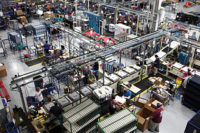Companies have long used simplicity to improve what they do. The best example comes from the factory floor, where lean practitioners use the backplane of process simplification to take out waste and improve productivity and quality. It’s here where the simplification toolbox is most fully developed.
Lean’s methodology and tools are simple (in the straightforward sense, not the easy sense). To simplify operations, they find waste and eliminate it. But simplicity is not that simple, and neither is lean.
There are many simplification methodologies, but lean is the most effective by far. Why? What sets lean apart? Lean is so much more effective because it simplifies the most important complicating element—people.
Done right, lean respectfully eliminates complexity in people’s work, not by dumbing down, but rather by freeing up. Lean applies not just at the work instruction level, but at all levels up to the company’s mission and vision. People know how to do their work. More importantly, they know why they are doing it. That is lean’s complexity-busting magic.
The payoff for simplification is not limited to processes and the factory floor. That’s why lean has been pushed into other business functions. But for complicated reasons, the simplification juggernaut has not breached the door to the most waste-laden element of your company—your product. Your product is the very source of your waste.
Using lean to simplify the product will not work. The tools are different, and the processes are different. In product design, information flow, not product flow, is the objective. However, the complicating element in the design suite is the same as it is on the shop floor—the people.
Like lean tools, the tools for product simplification are simple. Instead of value stream mapping, it’s part count reduction. (There’s no waste from an eliminated part, it’s that simple.) Though the method is simple, many design engineers don’t know how to do it.
Let’s apply lean’s five whys to the problem. Why don’t design engineers know how to reduce part counts? Because they were not trained to do it. Why? No one thought to train them. Why? Design engineers create function and launch products. Reducing part counts is not top of mind.
Why? The answer to that one is complicated. When manufacturing started, work was broken into chunks, people’s skills narrowed and efficiency improved. From then on, the chase for efficiency further narrowed skills and reduced chunks. To ensure efficiency improved, fiefdoms were created and were measured to death. To systematize creation of walls and moats, financial accounting rules were invented, and local optimization was officially renamed Generally Accepted Accounting Principles.
As companies grew larger, they needed an organizational framework to keep everyone in line. The best model of the day was borrowed from the military. Suddenly, cross-division rivalry became part of the manufacturing lexicon.
Product simplification doesn’t happen because of the specialized organizations we created, and because of the specialized metrics we put in place to measure them. In the quest for efficiency, we narrowed and walled off, until we have product people who are measured on function and process people who are measured on cost.
The bad news is the good news—we created it, so we can dismantle it. Start by educating on the upside of product simplification—radical material cost reduction. Cost reductions of 40 percent are possible! Then draw up a reinvented supply chain with the problem children designed out. Then, design your new product with half the parts, and repeat.




